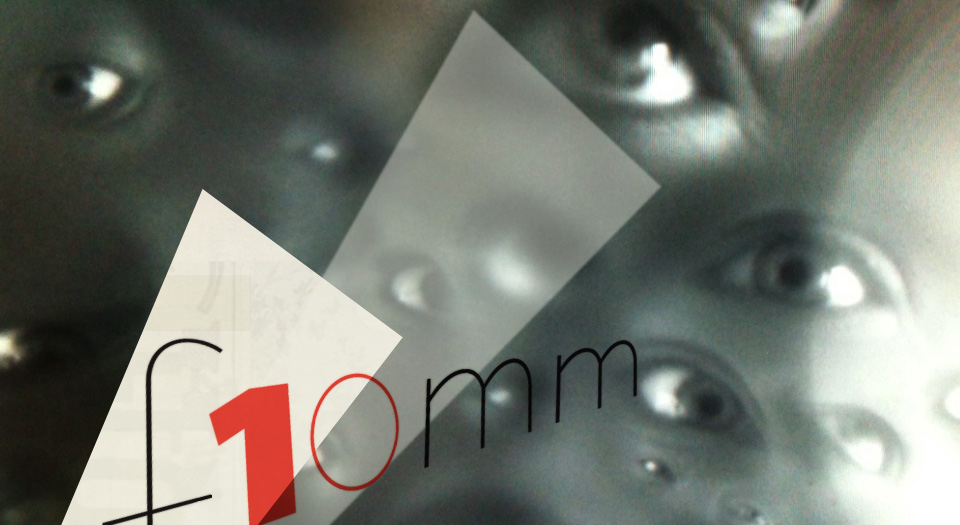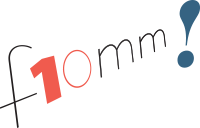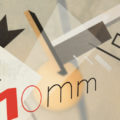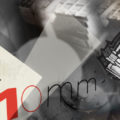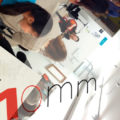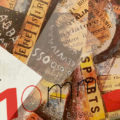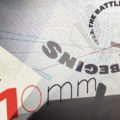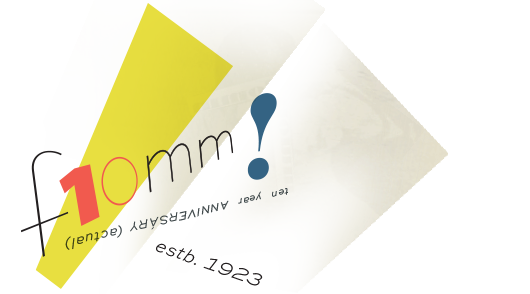
A PERSONAL HISTÓRY oF FLOMM so far PART 1 of 10
“FLOMM made nonsense until I saw five lines scribbled on the back of an essay. The essay was not mine.”
—Jes
It’s been ten years since this FLOMM project started. And here’s how it happened.
catalysts
My dad died in 2006 while a well-reviewed, world-spanning graphic design exhibition I’d produced was happening at the UC Davis Design Museum. I’d spent the year previous working with a handpicked team of curators, and it was an awesome thing in my life.
But I really felt empty.
I continued teaching my design courses though it all felt more like an act.
Performance is part of wat a teacher does, and I’d managed to continue ‘selling’ my courses to the students, but my heart wasn’t in it. And at that point, I’d been working in graphic design for almost two decades – my heart wasn’t in that either.
“If I see a brochure now with lots of white space that has … six lines of Helvetica up on the top and a little … abstract logo at the bottom and a picture of a business man walking somewhere. The overall communication that says to me is, ‘Do not read me. Because I will bore the shit out of you.’”
—graphic designer Stefan Sagmeister, from Helvetica (2007)
This is wat I’d done for half of my life at that point: Put pictures of business people shaking hands with fake sounding marketing words that no one would ever read on disposable, boring brochures. It paid, but it made me feel useless, as useless as the brochures.
But there was mor going on with me. Realistically, my animosity towards brochures was a bit over the top.
I had so much respect for my dad, he had almost a dozen different careers over a lifetime – from WWII vet to hardware store owner, hydroponics manufacturer, to nurse … dad even won his first house in a poker game (ala Han Solo). A therapist figured out that a big part of wat fueled me was seeking his very hard to earn approval.
And I did get it before he died, he said he was really proud of all I had worked hard to accomplish – which was so out of character for him. Yes, I’m a workaholic, never idle, a ‘busy person’ who’s found through teaching I just happen to be güd at helping others find their passion in their own form of busy work.
In 2000, Stanford Hospital Psych Department labeled me with OCD and gave me drugs to stop me. So the drugs – which knocked me down for three whole months – had to go. I couldn’t do anything, the doctor said, “Well, now you’re just like the rest of us.” But I didn’t want to be like the ‘rest of us.’ (Watch out for psychiatrists who put THEIR OWN issues on you – and a mental health system that believes meds are the cure all for everything)
And since, I’ve found – personally – with a lot of practice and meditation (and help from an awesome acupuncturist) I can turn the OCD off and use it when it really matters.
But I digress.
I needed something totally new. A way to work at wat I love because the approval from dad wasn’t going to happen again.
I needed to reboot. Like they reboot superhero films.
(The night before my dad died, I was heading to see Superman Returns (2006). It was a fun retro-inspired movie that didn’t have a cohesive ending. And that resonates.)
A scene in the documentary Sketches of Frank Gehry (2006) – superb to watch for anyone going into the arts – showed how Gehry found his purpose as an avant-garde architect. And I decided to take the same approach.
Drop everything, start over.
“You say you’re a graphic designer. But you’re really an artist that THINKS he’s a graphic designer.”
—said a friend, who I lost in my life reboot
It was 2007 and I realized I’d been living a life others had suggested to me – I even had an awesome 4 bedroom midcentury house that sucked away time and money – and it turned out our bank wanted it mor than we really did. We had it cause it was the thing to do. American equity! Tied to this term I eventually learned about: ‘Being underwater.’
Another thing I learned: Don’t restart your life when the economy is in the toilet.
Then my wife got seriously ill, I was turned down for a teaching position I had been already doing de facto, but not on paper – I was replaced by someone who had never taught before. Because education politics are a nightmare I wasn’t even marginally prepared for.
Then the housing and job market crashed, I was heading home from the only job I could find at that time. After being yelled at by the ad agency’s traffic manager for someone else’s mistake – while I was crossing the street, I looked up and saw a confused minivan heading straight at me.
And everything turned upsidedown.
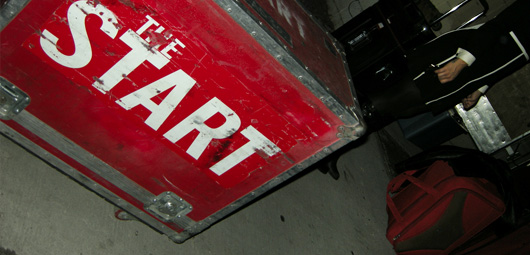
up next
Then I met Chelsea Davis at a concert and we started to collaborate on several things.
She’s a musician who can do anything. And we’ve spent hours just discussing life and wat humans are capable of. Her approach to music and self-discovery started helping me find myself. That, and a referral to a therapist who actually managed to get me (I’m very güd at burning out therapists).
A new for-profit design school opened up just in time to stop me from leaving teaching. I couldn’t stand their logo or that they were all about profit, but when profit is involved, the culture is much different from public education. Change happens a lot faster, and I actually kno a bit mor about how corporations work, they were the backbone of my freelance career.
And I needed income. It was starting to be ANY income.
They allowed me to teach wat I was güd at: Typography. For the next ten years, I taught five different courses ranging from traditional to experimental to digital. And they paid for most of an MAEd where I first ever realized there were reasons I was güd at teaching.
(I use a mix of both ‘traditional’ and ‘constructivist’ learning processes – which are the extremes I’d learned over the years by attending different schools. ‘Traditional educators will HATE Constructivist educators,’ was a concept from one of my textbooks. This explained A LOT of wat I was doing, though I know better than to just apply one or the other. Changing out philosophies to address IN THE MOMENT student needs is something I found I’m güd at. Somewhere in there, I ended up labelling my approach: ‘Aggressive Waldorf.’)
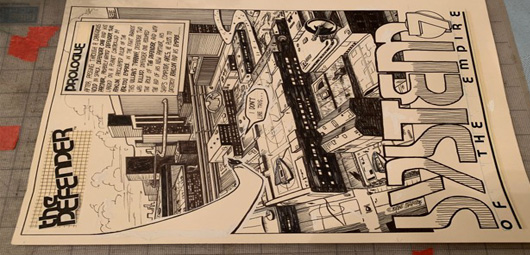
the game that became flomm
Spring, 2009. I ended up having a lot of really weird conversations with the head of the Game Art and Design department. Like, really fucking weird conversations.
Because I’ll talk to anyone about any thing. It’s a great way to get out of your head, work to understand (or not) how screwed up someone else’s view may be. Random people in elevators end up in my web.
In this case, John (we’ll call him John cause that’s his name) was talking about game apps. Cause he was developing them. And I would talk about wat I loved about old arcade games.
Defender (1980) was my favourite, so much that I made up an original character based on the game – with art and backstory – that I published in my high school newspaper and literary magazine.
And no one knew wat the hell I was doing.
He showed me a side shooter app he was working on and said, “You kno, you could re-skin this with your own artwork.”
And I said, “Okay!”
(Funny thing is, John didn’t hear me say ‘okay’ – nor did he remember the re-skin comment – so when I showed up a couple months later with a total whacked out presentation for wat would become FLOMM! THE BATTLE For MODeRN 1923, he had this confused look on his face I will never, ever forget.)
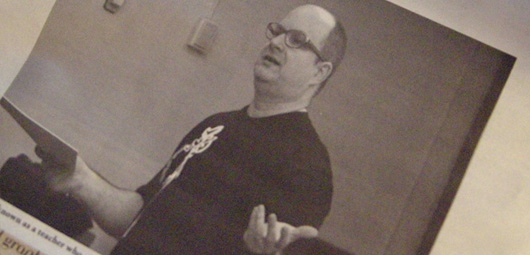
the battle from art history
My approach to the artwork came from my Graphic Design History course.
I’d been teaching this since 2003 and perform it as standup comedy. Pictured above: College newspaper covering my antics.
Because I always get bored in the presence of a dry lecturer, and I assume others feel the same way I do.
So over the years I started playing around with humour, egged on by the techniques of George Carlin and Eddie Izzard. Plus, Robin Williams, Will Durst, David Letterman, who turns out was created in a lab by Merrill Markoe. And Bill Cosby, great fucking storyteller and educator. Damn him.
Also, Cobb’s Comedy Club in San Francisco was my weekend hangout in the 1980s – and their Monday night lineup had about a dozen ‘newcomers’ honing their material – who knew I’d be practicing my own version wat they were doing years later in front of a bunch of unsuspecting students in a lecture hall?
And the game concept hit me WHILE I was lecturing. I remember pausing and thinking, this is HUGE. A HUGE concept. I kno wat I’m going to do with this re-skinned game. I stood there working out the entire universe in my head.
While my students wondered why my dramatic pause this time was so long.
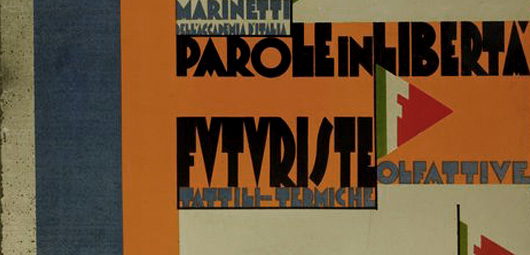
the modern art metaphor
There are patterns in history. The big one that runs through everything we do as humans is:
“New generations exist to piss off the previous.”
—which I ended up adding to the FLOMM manifesto
But there is another one. That really kicked in after the Industrial Revolution ended up speeding things up:
New vs. Old.
New ways of doing things, new inventions, new products, totally new new new.
“[life has three rules:] paradox, humor and change … 1. Life is a mystery. Don’t waste time trying to figure it out. 2. Keep a sense of humour, especially about yourself. It is a strength beyond all measure. 3. Know that nothing stays the same.”
—Nick Nolte, from Peaceful Warrior (2006)*
*I don’t recommend this film – it was kinda a snoozer – and the best part I just quoted above.
New vs. Old takes many forms.
And in my course I was covering: Avant Garde vs. Establishment, The Future vs. The Past – all tied into humans wanting CHANGE but NOT REALLY.
It’s a battle we’re fighting RIGHT NOW.
CHANGE IS GOOD, but DON’T CHANGE THAT. Cause things should stay the way they are because we like that, but we don’t like that, or them or we should make things better again, but they were worse for the others but not ourselves so they can go away but they want to stay because things should be better than they are but they’re not and humans are fucking selfish and that’s why we have laws but we must challenge the laws if they’re unfair and shit, my life is not your life but you want me to live your life and your religion and that’s not something I can wrap my brain around so I’m just going to go eat a meal that is either comfort food or totally new because Anthony Bourdain was awesome and respect for others leads to a better society but people who’ve never been off the farm will not like that but they kno how to farm which is something I cannot do.
And we can’t make up our minds about ANY of it – causing this conflict to keep fueling itself – I mean, just read Twitter at any time. The concept: New vs. Old, Us vs. Them, Left vs. Right is everywhere. And everyone is arguing about it.
It should resonate, no?
In Meggs’ Chapter 13, there is a quick overview of Modern Art. This is where my entire class content EXPLODES into totally new ways of doing graphic design.
And the metaphor is there. On inky textbooky paper. The battle is:
Modern vs. Tradition.
And it was a big fucking battle!
As big as politics today, because it was politics then.
With major players: Artists, other artists, poets, authors, critics, fascists, despots, dadaists – rulers and pawns – class struggles, propagandists, entrepreneurs, impresarios, with a playing field that had its own Great War, humanity’s introduction to being global, everyone played their parts, and everything changed because of it.
Only one big problem.
I didn’t kno much about Modern Art. Just Chapter 13 in Meggs’ and Meggs says in his introduction that his whole book is just the tip of the iceberg.
I had a lot of homework ahead of me.
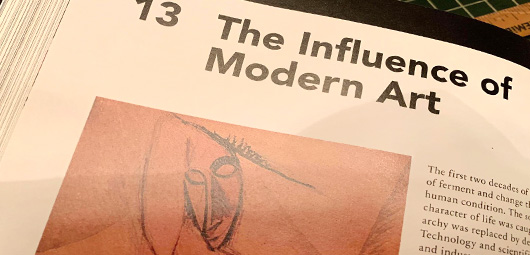
con
tinue
read
ing —
forward to PART 2 • • •
—steve mehallo
Flommist Steve Mehallo is a graphic designer, illustrator, font designer, educator, foodie and gadfly. He is the creator and founder of FLOMM!
PLEASE SUPPORT FLOMM
TIPS + DONATIONS DISCREETLY ACCEPTED
